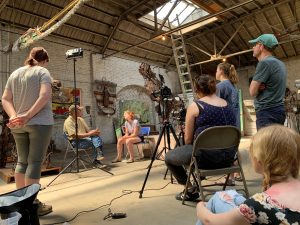
From the Winter 2019 Collegian | At UA, art isn’t confined to the walls of studios; it bleeds out into the community. Two classes teach students not only how to advance their skillsets, but how to use art to become good stewards of their communities through photography and sculpture.
Documenting the Greats
UA art professor Christopher Jordan spent the spring and interim semesters with his photography students in Alabama’s Black Belt, where they met some of the region’s most beloved artists. Here, they partnered with local organizations, such as Black Belt Treasures Cultural Arts Center in Camden to make photographic portraits of artists from all over the region, such as sculptor Charlie “Tin Man” Lucas and quilters Tinnie and Minnie Pettway.
“A lot of the artists who live and work in the Black Belt are becoming more advanced in age, and they have very compelling personal stories,” Jordan said. “Many of these artists have lived their whole lives in the region. This area was, historically, a plantation and sharecropping region, then became central to the civil rights era. It’s a vital region historically, as well as culturally, in part because of the many artists that live here. So we felt that it was really important to document these artists.”
Many of the students involved in the project had picked up a camera only a handful of times before joining Jordan’s class, but by the end, they were well-versed in both the technical and aesthetic skills required to create dynamic portraits and video interviews. Arielle Gray, a senior majoring in art and concentrating on photography, says that doing documentary work out in the field is an immersive experience that allows students with all levels of experience a place to cultivate a wider skillset.
“I had to learn how to use video, which was something I hadn’t really done before,” Gray said. “I had to learn how to do audio for the video and how to frame the video. And I also got to practice really getting to know my subjects for portraits and creating a space where people feel comfortable. The more that I practiced these skills, the better I got. It was great practice and produced really good results.”
The class was, in part, made possible by a partnership with Canon Solutions America, whose interest in supporting educational initiatives led them to lend professional-grade cameras and grant support as part of their Future Authors Program. The outcomes will be a printed book of artist portraits, an exhibition of the photographs, as well as an archive of the photographs and interview materials in the UA Digital Humanities Library.
“Canon’s involvement has been really, really helpful,” Jordan said. “They asked what I needed to facilitate something like this, and really delivered. They gave us professional camera equipment so the students could have an experience with something that they wouldn’t otherwise have a chance to use.”
The Monster Makeover
UA’s sculpture program recently partnered with the City of Tuscaloosa and the Tuscaloosa News to create a new public art installation known as the “Monster Takeover.” The small bronze sculptures scattered throughout downtown Tuscaloosa and the Riverwalk are inspired by drawings from elementary school students, who create their own monsters for the Tuscaloosa News’s “Monster Makeover” art show every October. Then, Craig Wedderspoon’s public sculpture class put their own spin on these creations, bringing them to life throughout the semester.
“The class is geared towards getting out and actively engaging with the community,” Wedderspoon said. “It gives the students an opportunity to do something that’s lasting. They contribute something that’s relatively permanent to their community. It’s how artists perform social responsibility.”
Once the sculptures are finished, they’re placed beside the sidewalk and on rails, while others lurk under bridges or on top of columns. Over the past two years, Wedderspoon’s public sculpture class has increased the city’s monster population to nearly 30, which they hope tourists and Tuscaloosa natives alike will find to be a fun addition to the cityscape.
The students who create the monsters choose which drawing they want to reimagine at the beginning of their class.
Ringo Lisko, a senior studying art, spent the semester creating a lobster-like creature with horns based off a drawing by a Myrtlewood Elementary School student. She believes that these students seeing what they dreamed up in a public place could positively influence their views on art in the future.
“I think it’s a really good way for kids to see that their art matters,” Lisko said. “When you’re that young, it’s a huge opportunity to have someone take this drawing that you did in class and put it out for the public to see.”
At UA, students and faculty alike work to encourage a thriving, tight-knit art community that supports artists of all walks of life. Whether they’re out exploring the art of other communities or creating their own, the promotion of public art is quickly becoming one of the pillars of the University’s art scene.
“Art helps build culture,” Wedderspoon said. “Any healthy community and economic environment needs culture. Public art becomes a destination point in an area—it brings you from one spot to another. So it’s really great for the community as a whole.”